Features of agricultural technology of the variety “Loving Heart Red”
Tomatoes are the most favorite vegetable of most gardeners, not only in Russia, but also in other countries. For example, in the USA, 93% of garden plots are sown with tomatoes. That is why every year the State Registers of different countries are replenished with new names of tomato crops. Russia is one of the leaders among varietal developments, characterized by increased adaptation to any weather conditions and excellent taste properties of ripe fruits.
Today we will talk about the Loving Heart red tomato, which, despite its short existence, already has many loyal fans among summer residents.
Characteristics and description of the tomato variety Loving Heart Red
The Ural Summer Resident company offers to evaluate the new tomato variety Loving Heart Red. The variety is young, is under experimental testing, and therefore has not yet been included in the State Register of Breeding Achievements.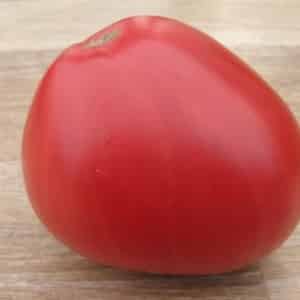
Plant type indeterminate, which means unlimited growth of the main stem. To determine the growth point, pinching is carried out. Height is 1.6-2 m. On one seedling, 5-6 fruit-bearing branches are formed, 1 branch bears 5-7 fruits. The stem is powerful, the foliage is medium. The first inflorescence is formed above the eighth leaf.
A mid-early species, 95–110 days pass from the moment of sowing the seeds to full ripening. It is distinguished by increased immunity to dangerous diseases of the nightshade family and good adaptation to unfavorable climatic conditions.Recommended for cultivation in open ground and greenhouse conditions.
The yield is high: 10–15 kg are harvested from one seedling, provided that 3–4 plants are planted per 1 square meter. m.
The culture requires obligatory staking and regular pinching due to the large number of side shoots.
Description of fruits
Average weight - 600–800 g, heart-shaped, bright red color. The taste is sweet and delicate, harmoniously combined with spicy sourness. The pulp is juicy, fleshy, there are a lot of seeds. The peel is thin, so tomatoes do not have a long shelf life. Ripe vegetables are immediately used for food or for processing to prepare tomato products.
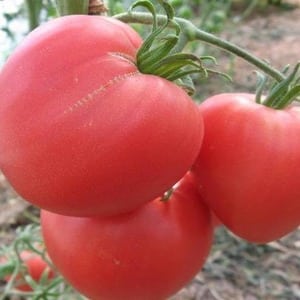 The purpose of the fruit is universal. Perfect for any fresh dishes and for winter preparations. Delicious juices, pastes, ketchups and adjika are obtained from these tomatoes.
The purpose of the fruit is universal. Perfect for any fresh dishes and for winter preparations. Delicious juices, pastes, ketchups and adjika are obtained from these tomatoes.
The photo shows Loving Heart tomatoes.
Pros and cons of the variety
Like any other variety, this tomato has positive and negative sides.
The benefits include:
- high productivity;
- adaptation to any weather changes;
- disease resistance;
- possibility of growing in a greenhouse and in open beds;
- ease of care;
- excellent taste;
- large fruits;
- versatility in cooking.
In addition to the above advantages, you can add one more, which is important for gardeners. The culture is not a hybrid and retains the parental genes in the next generation. This means that each gardener will be able to prepare seeds for the next planting on their own.
Disadvantages of the variety:
- mandatory garter;
- regular stepsoning;
- short shelf life of ripe vegetables;
- poor transportability.
Despite the last 2 points, the crop is grown on an industrial scale due to its high yield. Tomato is in considerable demand in markets.
How to grow a tomato
The Red Loving Heart tomato does not belong to capricious crops. During the entire growing season, regular watering and several feedings are enough for it.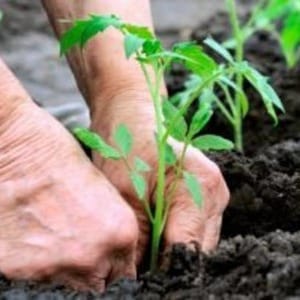
Planting stages
Like many varietal crops, tomato is propagated through seedlings. Sowing of seeds begins 2 months before planting in the ground. But before sowing, it is necessary to carry out a number of measures to improve their germination.
Select a container and prepare the seeds for sowing
The initial stage of preparation is seed rejection. The seed material is laid out on the table and carefully inspected for visible damage. Then they check for emptiness, since empty seeds will not germinate. To determine the emptiness of seeds, 1 teaspoon of salt is dissolved in a glass of water, and the grains are placed in the solution for 10 minutes.
Those that float to the surface are disposed of. The remaining seeds are disinfected in a weak solution of potassium permanganate for 20 minutes. They are then washed with running water and dried.
Important! The main goal of seed disinfection is the prevention of diseases and pests.
To improve germination, seeds are placed in growth stimulants for 10 hours. Such drugs include “Epin” or “Kornevin”. In addition to specialized substances, aloe juice or melt water performs the function of a stimulant.
Reference. Melt water can be obtained from melted snow. But before soaking the seeds, it must be warmed to room temperature.
As for the container, you can plant it in a common container or in individual containers. The common container is a wooden box, and individual containers are plastic and peat cups.If the container was used for last year's plantings, it must be disinfected with a weak solution of manganese, as pathogenic spores may remain in it.
In the prepared containers, small drainage holes are made at the bottom, where excess moisture will drain. Drainage holes are especially necessary in plastic cups to avoid the development of diseases such as blackleg.
Reference. Blackleg is a fungal disease characteristic of the seedling period. Causes lodging of seedlings and their death.
The soil is prepared from garden soil, peat and humus in equal quantities. River sand is added as a leavening agent. After thoroughly mixing the components, the finished soil is spilled with a hot solution of violet manganese to destroy pathogenic flora. After the soil has cooled, it is laid out in planting containers, filling them two-thirds.
Sowing
The seeds are buried 1.5 cm, maintaining a distance of 2–3 cm between them. Sprinkle peat on top, lightly moisten with a spray bottle with warm, settled water and cover the containers with film to create greenhouse conditions. The seeded containers are left in a warm place at a temperature of 23–25 °C.
Seedling care
After germination, the film is removed and the containers are placed on the windowsill. If there is insufficient daylight, the seedlings will stretch and weaken. Therefore, additional lighting is installed in advance, especially in regions where the day length is short.
Water with warm, settled water using a shallow watering can, without flooding the seedlings. Excess moisture negatively affects the root system. After watering, the soil is loosened superficially, improving the air permeability of the soil.
When two true leaves form, the seedlings are planted in separate containers. If the seedlings are left in a common container, then the distance between the bushes is increased to 15 cm.
Important! During picking, only strong and healthy plants are left for further growth.
Two weeks before transplanting, the seedlings begin to harden. First, they are left outside for 1 hour. Every day the time increases. At the same time, the night temperature in the room is reduced to 12 °C.
Transplantation into the ground
Transplantation is carried out 2 months after sowing the seeds. By this time, the bushes have 5–7 true leaves, a strong stem and a formed root system.
The holes are prepared in advance with a depth of 20 cm. One tablespoon of ash is placed at the bottom of each of them and filled with warm water.
Transplant seedlings in the evening or on a cloudy day. Choose a place for tomato beds that is sunny and protected from drafts.
After planting, water again and leave the seedlings to adapt to the new location. During adaptation, young plants are not watered or fed.
Planting pattern: 40 cm is the distance between seedlings, 60 cm is left between rows. For 1 sq. m place no more than four plants.
Tomato care Loving heart
Proper care of any crop increases its immunity and helps to achieve the highest fruiting rates.
Watering and fertilizing
After the seedlings take root, perform the first watering. Water with warm, settled water, strictly at the root, after sunset or in the morning. Regular watering is established no more than twice a week. It is important not to over-moisten the soil, so as not to provoke the development of fungal diseases.To keep the beds moist longer, they are mulched with dry leaves or straw.
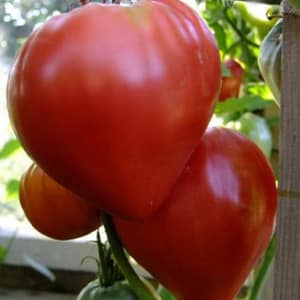 After watering, the soil is loosened, removing weeds with roots. Weeding the beds is mandatory, since the weeds are home to a large number of pests.
After watering, the soil is loosened, removing weeds with roots. Weeding the beds is mandatory, since the weeds are home to a large number of pests.
The crop is fed three times during the entire growing season. The first fertilizing is applied two weeks after transplantation. Fertilize with a full complex of minerals.
Second feeding applied during the formation of ovaries. Plants are fed with fertilizer containing phosphorus-potassium substances. 2 liters of fertilizer are used for 1 seedling.
Fertilize the third time during fruiting. Feeding is provided by a full complex of minerals.
Important! All fertilizing is applied immediately after watering.
Shaping and garter
The maximum quantitative indicator is achieved when maintaining a culture of 2 stems. To do this, leave the stepson above the first flower brush. All other stepsons are regularly removed.
The pinching procedure is carried out early in the morning so that by the evening all the wounds have time to heal. To avoid infections, the cut sites are treated with a weak solution of manganese.
Reference. Stepsoning – removal of excess shoots from plants.
Those who grow indeterminate plants on their plots know that garter is inevitable. During transplantation, a wooden or metal support is installed. The stem is fixed almost immediately when planted in the ground. This helps it form smooth and strong. As they grow, fruit-bearing branches are fixed to the support, otherwise they will not support the weight of ripe fruits.
Harvesting
Ripe vegetables are harvested every 3–4 days, thereby unloading the bush for faster ripening of the remaining vegetables.In areas with cold summers, not all tomatoes have time to ripen in the garden beds, so they are picked unripe. They are left to gain color in a cool, dry room.
Reference. If you leave a few red tomatoes among the unripe tomatoes, ripening will occur faster.
The use of tomatoes is universal: they are suitable for both fresh dishes and winter preparations.
Prevention of diseases and pests
According to characteristics and reviews, the culture is characterized by strong immunity to common diseases. Carrying out preventive measures is necessary if potatoes or peppers are planted next to tomatoes. These crops also belong to the nightshade family, and if they are infected, tomatoes can become infected.
Prevention includes:
- compliance with crop rotation rules. It is not recommended to plant tomatoes in the place where peppers, eggplants and tomatoes previously grew;
- moderate watering with humidity control in the beds;
- weed removal;
- mulching;
- ventilation of the greenhouse (if the tomato is planted in closed structures);
- annual change of the top layer of soil in the greenhouse;
- soil treatment with copper sulfate.
In open ground there is always a risk of pests attacking the beds, which can cause irreparable harm to all plantings. For preventive purposes, each bush is carefully inspected for the presence of parasitic insects.
If their quantity is small, it is possible to use traditional methods, for example, spraying with decoctions of sharp-smelling herbs or nettle infusion. But with large quantities, it becomes necessary to use insecticides.
Reference. When insects invade, not only tomato seedlings are treated, but also neighboring crops.
Farmer reviews
The opinions of those who planted the crop on their plots are especially important when the variety is on a trial period. Positive reviews guarantee that the tomato will take root in many beds and will be included in the State Register.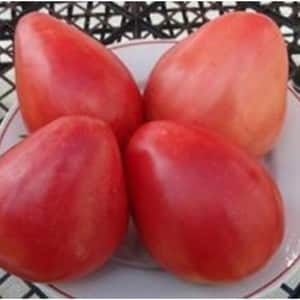
Evgeniy, Moscow region: «Tomatoes are my love, so I grow them in large quantities in my garden. Among the indeterminate varieties, I especially note the Loving Heart, as it tolerates sudden changes in temperature well, produces a high yield, and has good taste.”
Olga, Anapa: “I planted it for the first time this year and realized that I would plant it constantly, since the seedlings did not get sick, tolerated minor drought well, and produced a rich crop of tasty and large tomatoes. I’m very pleased with this unusual novelty among tomatoes.”
Conclusion
By planting the Loving Heart red tomato on your plots, you don’t have to worry about being left without a harvest. The culture can withstand cold and drought, does not get sick and does not require special attention. Large and sweet vegetables are good not only in summer salads and sandwiches, but also in tomato juice, rich in vitamins.
The Loving Red Heart variety is an excellent solution for lovers of large-fruited tomatoes living in the northern regions.